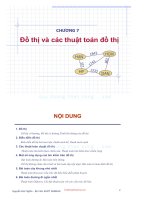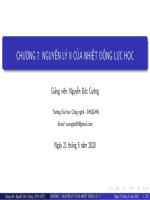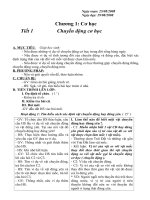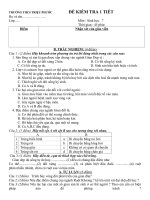7 nguyễn đức bảo hcm5 langnuage cultute 7050000445
Bạn đang xem bản rút gọn của tài liệu. Xem và tải ngay bản đầy đủ của tài liệu tại đây (102.03 KB, 9 trang )
INSTITUTE OF OPEN EDUCATION AND INFORMATION
TECHNOLOGY - HUE UNIVERSITY
FACULTY OF FOREIGN LANGUAGES
LANGUAGE AND CULTURE
MEDICAL DISCOURSE COMMUNITY: LANGUAGE,
COMMUNICATION, AND CULTURAL DYNAMICS IN
HEALTHCARE
Instructor
: TUAN NGUYEN VAN, MA.
Student
: NGUYEN DUC BAO
Class
: HCM5
Student’s ID : 7050000445
HO CHI MINH, August, 2023
MEDICAL DISCOURSE COMMUNITY: LANGUAGE,
COMMUNICATION, AND CULTURAL DYNAMICS IN
HEALTHCARE
Abstract
This thesis delves into the intricate realm of medical discourse communities,
where language, communication, and cultural nuances intersect to shape the practice
of medicine. Examining the interplay between medical professionals, patients, and
the broader healthcare landscape, this study seeks to unravel the complexities of how
communication within this discourse community influences healthcare outcomes,
patient experiences, and the overall dynamics of medical practice. By exploring the
linguistic, cultural, and communicative dimensions, this thesis sheds light on the
critical role that effective discourse plays in creating a bridge between medical
professionals and patients while navigating the challenges of modern healthcare.
I.
Introduction
In the rapidly evolving landscape of healthcare, effective communication stands
as a pivotal foundation for successful medical practice. Within this intricate realm,
the concept of a "medical discourse community" takes center stage, representing a
dynamic space where medical professionals, patients, and stakeholders engage in
dialogue that profoundly influences the understanding, diagnosis, and treatment of
illnesses. This community's linguistic practices, communication patterns, and
cultural dynamics intricately shape healthcare outcomes and patient experiences
alike.
Understanding the role of discourse in this context is paramount. The term
"discourse" within the medical arena refers to the multifaceted ways in which
medical knowledge is shared, understood, and applied. Adopting a linguistic lens,
discourse serves as the conduit through which medical professionals convey intricate
information, enabling accurate diagnosis and tailored treatment recommendations.
Importantly, the significance of discourse extends beyond the realm of individual
interactions, influencing both macro-level societal perceptions of healthcare and
micro-level doctor-patient exchanges.
Through an exploration of the interplay between language, communication, and
culture within the medical discourse community, this thesis aims to shed light on the
critical role that effective discourse plays in building bridges between medical
professionals and patients. As the field of medicine continues to evolve, navigating
the challenges and opportunities of modern healthcare requires a comprehensive
understanding of the nuances that underpin this complex communication network.
II.
Content
1. Defining Medical Discourse
The term "discourse" within the context of medicine refers to the interconnected
ways in which medical professionals, patients, and even family members
communicate about health-related matters. This study adopts a linguistic
perspective, viewing discourse as the vehicle through which medical knowledge,
diagnosis, and treatment recommendations are conveyed. Moreover, the paper
highlights the dual levels at which discourse operates: the macro level influencing
societal perspectives on healthcare and the micro level guiding individual doctorpatient interactions.
2. Communication in Medical Interaction
Effective communication forms the cornerstone of medical interactions,
transcending mere verbal exchange to encompass a realm of non-verbal cues,
gestures, and embodied actions that are pivotal in patient-doctor dynamics. This
section delves into the multifaceted dimensions of communication within medical
interactions, highlighting its nuanced role in diagnosis, treatment decisions, and
patient well-being.
2.1 Non-Verbal Communication and Empathy
Beyond words, non-verbal communication takes on a profound significance in
medical discourse. The posture, gestures, and facial expressions of both medical
professionals and patients contribute to conveying empathy, trust, and emotional
connection. The gentle touch of a doctor's hand or the comforting nod of
understanding can often communicate more than words ever could, creating a sense
of rapport that fosters patient comfort and engagement.
2.2 Gestures and Diagnostic Clues
Gestures within medical interactions transcend cultural and linguistic barriers,
offering valuable diagnostic insights. Doctors often rely on patients' gestures and
movements to identify pain points, discomfort, and underlying issues. Equally,
patients communicate their symptoms through gestures, aiding doctors in making
accurate assessments. This intricate dance of gestures enhances the diagnostic
process, ensuring accurate treatment recommendations.
2.3 Cultural and Ethical Considerations in Communication
Communication in medical interactions is not only about conveying information
but also navigating cultural sensitivities and ethical considerations. Language
barriers and cultural differences can lead to misunderstandings, impacting diagnosis
and treatment. Moreover, ethical discussions—such as end-of-life decisions—
require a delicate balance of linguistic and non-verbal communication to ensure that
patients' values and preferences are respected.
In essence, communication within medical interactions extends beyond words,
weaving a tapestry of non-verbal cues, gestures, and cultural considerations.
Understanding and harnessing these dynamics fosters effective diagnosis, treatment,
and patient-centered care, highlighting the indispensable role of communication in
the medical discourse community.
3. Anthropological Insights into Medical Discourse
Anthropology offers a unique vantage point to explore the intricate interplay
between culture and medical discourse, unraveling the ways in which language
shapes and transmits medical knowledge within diverse societal contexts.
3.1 Cultural Construction of Medical Knowledge
Language is a powerful tool for constructing and transmitting medical knowledge
within specific cultural frameworks. Different cultures attribute varying meanings
to illnesses, symptoms, and treatments, shaping the ways in which medical discourse
unfolds. Anthropological inquiry reveals that medical language is not only about
conveying facts but also about reflecting cultural beliefs, values, and understandings
of health and wellness.
3.2 Language's Influence on Diagnosis and Treatment
The connection between language and medical practice goes beyond mere
communication; it influences diagnosis and treatment approaches. In some cultures,
certain illnesses may not have direct translations, leading to potential misdiagnoses
if not understood within the cultural context. Medical discourse transcends language
barriers by incorporating cultural insights, enabling doctors to tailor treatments that
align with patients' cultural backgrounds, beliefs, and preferences.
Anthropological insights highlight the dynamic relationship between language,
culture, and medicine. Acknowledging these dimensions fosters a more
comprehensive understanding of medical discourse, enabling healthcare
professionals to navigate diverse cultural landscapes while providing patientcentered care.
4. Globalization, Variation, and Communication
Within the realm of medical discourse, the forces of globalization and cultural
variation converge, shaping communication practices that transcend geographical
boundaries and embracing diverse linguistic and cultural perspectives.
4.1 Universalities and Cultural Diversity in Medical Discourse
Globalization introduces a paradoxical blend of universalities and cultural diversity
within medical discourse communities. While certain medical practices and
terminologies become globally recognized, cultural variations persist in shaping
how medical knowledge is shared, understood, and applied. Anthropological studies
reveal how these variations impact patient-doctor interactions and influence
healthcare outcomes across different societies.
4.2 Challenges and Opportunities in Cross-Cultural Communication
Globalized medical discourse underscores the importance of effective crosscultural communication. The ability to navigate linguistic and cultural nuances
becomes paramount in delivering patient-centered care. Healthcare professionals
must adapt their communication strategies to suit diverse audiences, considering
cultural norms and linguistic sensitivities. By embracing these challenges, medical
discourse communities can create opportunities for mutual understanding, enhanced
patient experiences, and the exchange of medical knowledge across borders.
Navigating the intersection of globalization and cultural diversity in medical
discourse communication is crucial for fostering effective cross-cultural healthcare
practices. By acknowledging both universalities and variations, medical
professionals can bridge linguistic and cultural gaps, contributing to improved
patient outcomes and a more inclusive discourse community.
5. Genre, Register, and Textuality in Healthcare
The multifaceted landscape of medical discourse encompasses various genres,
registers, and textuality, each serving as essential tools for conveying medical
information, ensuring accurate communication, and fostering patient understanding.
5.1 Diverse Genres for Medical Communication
Medical discourse unfolds across diverse genres, including medical documents,
patient histories, and research papers. Each genre carries a specific communicative
purpose, tailored to its intended audience. The usage of different genres allows
medical professionals to effectively convey complex medical information while
maintaining the integrity of their content. For instance, medical records ensure a
comprehensive overview of a patient's medical journey, while research papers
contribute to the exchange of cutting-edge medical knowledge among peers.
5.2 Interactional Textuality and Affective Communication
Interactional textuality in medical discourse involves both linguistic and nonverbal cues, offering a rich medium for conveying affective meanings and enhancing
patient experiences. Beyond words, medical professionals employ gestures, facial
expressions, and tone to communicate empathy, comfort, and understanding. This
form of textuality extends beyond verbal communication, influencing patient trust
and fostering a healing environment. Interactional textuality, encompassing both
written and non-verbal elements, enriches the fabric of medical discourse, enhancing
both diagnosis and patient satisfaction.
Incorporating diverse genres, registers, and interactional textuality within
medical discourse not only facilitates effective communication but also amplifies the
human aspect of healthcare. By recognizing the nuanced role of these elements,
medical professionals can create a more holistic and empathetic discourse
community that resonates with patients and advances medical practice.
6. The Future of Medical Discourse: Challenges and Opportunities
As medical discourse continues to evolve alongside technological advancements
and cultural shifts, a host of challenges and opportunities shape the landscape of
communication within healthcare communities.
6.1 Adapting to Technological Advancements
The future of medical discourse is intrinsically tied to technological innovations.
With electronic health records, telemedicine, and AI-driven diagnostics becoming
integral, medical professionals face the challenge of navigating these platforms
while ensuring effective communication. Embracing digital tools offers
opportunities for streamlined data exchange and remote consultations, enhancing
patient access and outcomes.
6.2 Navigating Cultural and Linguistic Diversity
In an increasingly globalized world, medical discourse must address cultural and
linguistic diversity. Healthcare professionals encounter patients from diverse
backgrounds, necessitating sensitivity to communication barriers. The challenge lies
in developing culturally sensitive discourse practices that transcend linguistic
differences, ensuring accurate diagnoses and patient-centered care. Bridging these
gaps offers an opportunity to enrich medical discourse by embracing a broader
spectrum of perspectives.
As the medical discourse community ventures into the future, balancing
challenges with opportunities requires a proactive approach. By harnessing
technology and embracing cultural diversity, healthcare professionals can pave the
way for more inclusive, effective, and patient-centered communication practices,
thus fostering a thriving discourse community.
III.
Conclusion
In the intricate realm of healthcare, the nexus of communication, culture, and
medical knowledge gives rise to the dynamic concept of the medical discourse
community. This community transcends mere dialogue, weaving together language,
gestures, and cultural nuances to shape healthcare interactions, diagnosis, and
treatment. The power of discourse lies not only in its ability to convey information
but also in its capacity to build bridges between medical professionals, patients, and
diverse stakeholders.
As this thesis has unveiled, effective communication within the medical
discourse community is a multidimensional endeavor. From the intricate dance of
non-verbal communication to the harmonization of diverse genres and registers,
every facet plays a pivotal role in ensuring accurate diagnosis, empathetic care, and
cultural sensitivity. The future beckons with the promise of technological innovation
and the challenge of navigating cultural diversity, both of which hold the potential
to further enrich medical discourse practices.
In embracing these challenges and opportunities, healthcare professionals stand
poised to elevate the discourse community. By recognizing the intricate connections
between language, culture, and medicine, the medical discourse community can
continue to evolve as a space that transcends geographical, linguistic, and cultural
boundaries, fostering effective communication, patient-centered care, and the
advancement of medical knowledge.
References
1. Zaoutis, L. B. (2007). Comprehensive pediatric hospital medicine.
Philadelphia: Mosby/Elsevier.Moreno, Miguel.
2. Kaitlyn, B. (2012). Medical Discourse Community by Kaitlyn Bodine on
Prezi. Prezi - Ideas matter.
3. Ennis, M. (2004, September 15). Medical Discourse: A Glimpse into
Communication in a Healthcare Environment . Sullivan Files.
4. Bruce, V. (Director). (2011). Doctor/Patient Communication. U.S.:
Discovery Communications, Inc.
5. Strand, R., & Amanda, T. (2012). The Analysis of Medical Discourse
Community . SD State.
6. “Federal Grant Writing Manual.” Federal Grant Writing Manual | National
Rural Health Resource Center. National Rural Health Resource Center, n.d.
Web. 26 Feb. 2017.
7. Dr. Kishore Murthy (2000), Doctor Patient Communication, pp.153.









